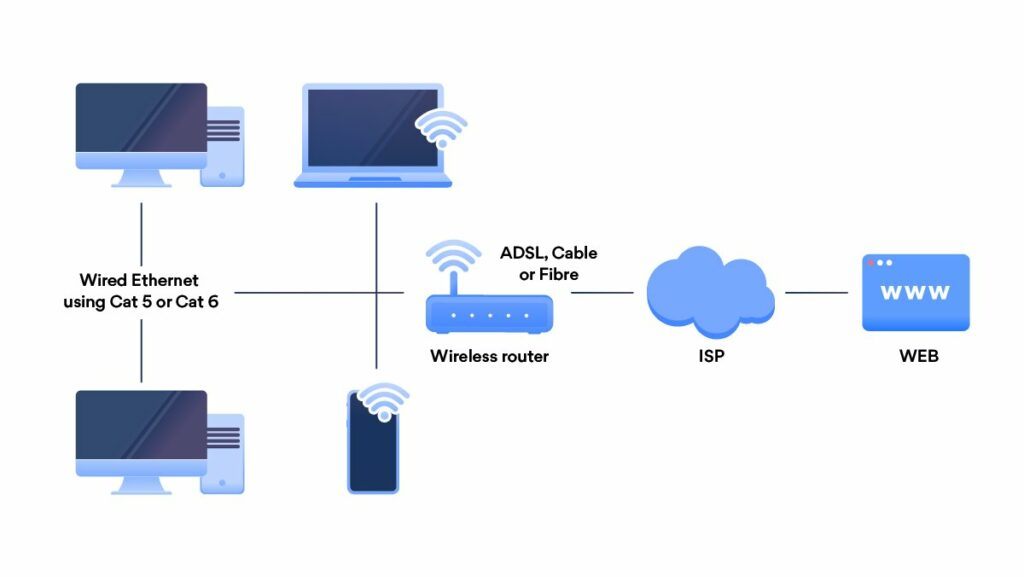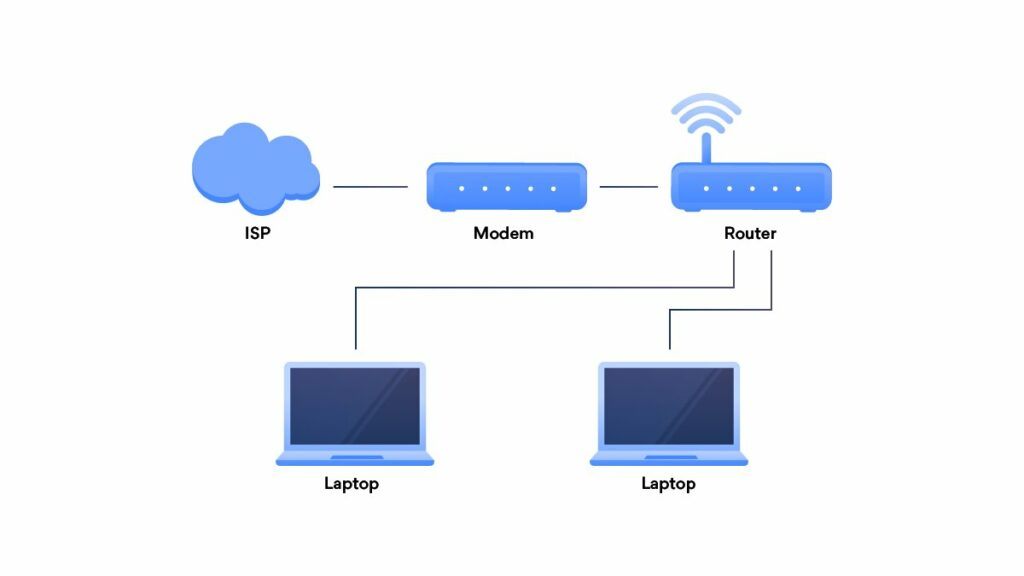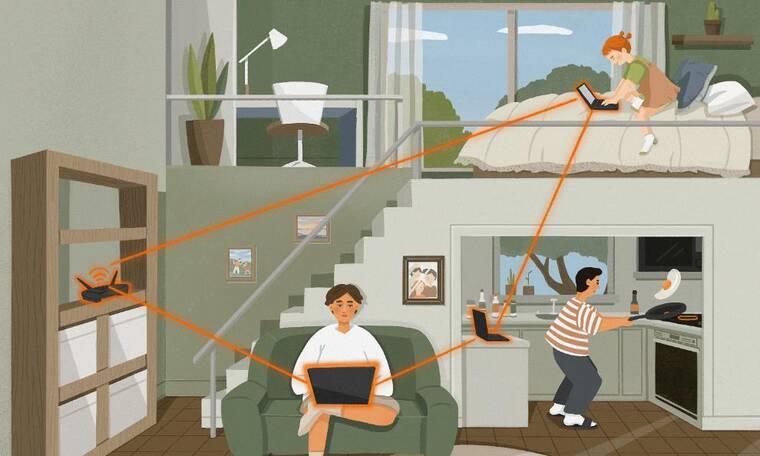If you're building a home network, there are some key decisions to make along the way. With the right tools and techniques, home networking will make life easier while also keeping you safe. Here are some ideas for building a home-friendly network—starting with the basics.
What is a home network system
A home networking system is a group of devices connected in a single network near your home. These network devices are connected to each other and can interact within the network. Users typically use Wi-Fi to connect multiple devices to the network. However, it is also possible to use the old-fashioned way and connect them via a network cable.
Home network systems make the use of smart devices more convenient. It allows you to:
- Communicate with all devices
- Access files from any device connected to the network
- Printing from Multiple Computers on One Printer
- Manage security settings for all connected devices from one place
Home Network Setup: What You Need
Whether it's a wired or wireless home network, most networks typically contain the following elements:
- router or wireless router
- access point or point
- Ethernet hub or switch
- ethernet cable
- Broadband filter
Filters out the DSL signal on the phone line so that the phone can work with broadband.
Home network IP address
Home network uses twoType of IP address– Private and public. Private IP addresses are used for communication between devices in the home network, while public IP addressesIPThe address is for the public network. A public IP is assigned to you by your internet service provider, and your router uses it to communicate with the wider network. It represents your entire network and is essential for network connectivity. A dedicated IP is assigned to your device by your router.
How to set up a home network
What types of home networks are there?
First you need to decide whether your home network will be wired or wireless. Here are the pros and cons of each method:
wired network
Wired networks are much faster. Its hard-wired connection means less interference. This type of network uses a UTP-based Ethernet cable to connect from the router to the device. Popular Cat5e cables can support speeds from 1000 Mbps to 1 Gbps (megabits per gigabit per second) at 100 meters, and Cat6e cables can do better. (Most wireless connections struggle to reach a few hundred Mbps per second.)
Pros
- safer
Hackers need physical access to wires to tamper with data on the network. However, your Wi-Fi connection can be disrupted by anyone within range -- even if they're not in your home. - higher speed
Each device is connected directly to the router at the same speed via its own cable. Because wired connections are less prone to radio interference, it prevents data from being retransmitted in the background. Wired networks are great for transferring large files faster, and for gamers who want to avoid latency issues and make sure they're not at a technical disadvantage.
Cons
- fluidity
Physically limited by the length of the cable. - connectivity
Handheld devices such as Kindles and iPads do not have Ethernet ports to plug in cables. - expensive
Devices such as switches, hubs, and cables are required to increase coverage, leaving more room for damage or error. Troubleshooting can also get messy.
wireless network
For wireless networking, a wireless device needs to be connected to a wireless router. Although wireless networks can be slower than wired networks in most cases, any number of devices can be connected.
Pros
- Simple and distraction-free
A wireless home network connects anywhere in the home without worrying about wiring. Setup is easier, and if you choose a wireless router with a web-based interface, you can view and control connected devices and devices. - Wireless Networks Improve Efficiency
Thanks to increased mobility, wireless networks can easily share information between devices anywhere in the home without having to connect the devices to a router to receive an Internet connection. In terms of cost, there are fewer cables to buy and replace, and it eliminates the stress of running cables through the house or having to pay someone to do it.
Cons
- less secure
Since wireless data is transmitted over the air, it may be easier for an attacker to intercept communications. - Slower
Wireless connections are prone to interference, which can slow down connections. Reinforced concrete walls, other nearby Wi-Fi hotspots, wireless devices, microwave ovens, and metal bodies all absorb Wi-Fi signals. The more connected devices you have, the slower your connection may be.
Combining wired and wireless
The two can be combined for the best home network setup:
Hardwire the devices that need a more secure or higher speed connection, and use the wireless connection for the rest. Say you work from home and want a super-fast wired connection in your living room, but you want Wi-Fi in your garden. You can connect your home devices to the router and run a Wi-Fi access point into a location where it can project a Wi-Fi signal into your yard.
Simple Home Network Setup Wiring Diagram
wireless setting

The wireless network diagram shows devices such as laptops and cell phones connected to a wireless router via Wi-Fi. Since some routers also include an Ethernet port, an Ethernet cable can also be used to connect a PC. Devices that are connected via a cable usually get a stronger connection - depending on cable quality/length, location and other household factors.
Wired setup

In a wired setup, the device is hardwired into the router to receive an internet connection, which should increase the speed significantly. Devices must have ethernet ports to connect them to the router using an ethernet cable, instantly picking out tablets, phones, and newer laptops. However, it is possible to plug in a wireless access point or switch to a router to connect any wireless device to the network.
Assembly parts
#1 router
Install the router in a central location in your home. Generally, the closer the device is to the router, the stronger the Wi-Fi signal.
For wired networks, use a high-quality Ethernet cable to plug the switch or Ethernet hub into a power outlet. Switches typically allow up to eight devices to be connected using Ethernet cables, assuming the devices have Ethernet ports.
Tip: Safety first!
Log in to the router's online settings page to configure the necessary security settings. (Instructions are found with or printed on the router).
- Change the default SSID and password
- Enable WEP security
- Turn on the firewall function
#2 Access Point
Access points can be installed in other areas of the home to extend the Wi-Fi signal to other devices. Most routers provide enough Wi-Fi range to cover most homes - larger buildings will require multiple access points and/or routers.
Connect the wireless access point to a wired router, or switch via an ethernet cable. For a wireless network, connect the access point to one of the ports on the wireless router, and then configure the wireless settings for the access point.
#3 device
Now you can connect your wired and wireless devices however you want, and more devices can be connected by introducing more switches and wireless access points. Keep in mind that having too many connected devices can weaken the Wi-Fi signal of your wireless network.
Home Network Security
It's time to start thinking about securing your new home network; otherwise, your hard work and expensive equipment could be lost to a cyberattack. It doesn't have to be intimidating either. You can start by creating some virtual local area networks (VLANs):
Create VLAN
Create VLANs to break up larger networks into smaller independent segments to keep devices private and reduce congestion on larger networks. For some, Internet settings can be controlled per network segment or VLAN to reduce congestion and increase speed. Multiple VLANs can be assigned to an access point from a router with a web-based interface.
They protect you by \below:
- Keep a separate guest Wi-Fi password
A separate guest domain with a separate password also gives it a different SSID or network name. It also locks selected devices, such as those containing sensitive files, network printers, and NAS drives. Guest access points will not be able to obtain information, evading malicious attempts to steal your data.
- Keep visitor traffic separate
your child may be playingGameOr playing movies constantly, generating a lot of traffic and consuming a lot of data. For example, if you work from home and don't want to block your main network – creating a separate VLAN for them can reduce the amount of traffic each network and device has to carry, providing the best speed possible.
VPN your router
There are many different ways to secure routers and remote access devices. Run the VPN on the router (virtual private network) may be a strong catch-all approach for encrypting all traffic from every device connected to the router, but this solution may not be suitable for everyone.Choose the best VPN router for your home and business.








